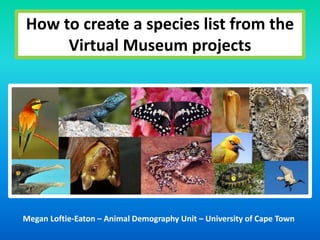
Create Species List Virtual Museum Projects
- 1. How to create a species list from the Virtual Museum projects Megan Loftie-Eaton – Animal Demography Unit – University of Cape Town
- 2. In this slideshow we provide the recipe to creating a species list of butterflies, directly off the current and live data in the LepiMAP database --- this process is the same for ALL other projects in the Virtual Museum. You don’t need to login to access the lists. They are available to you, free of charge, anywhere in the world!
- 3. The hardest part of getting a species list is knowing the “code” for the area you want a list for. These counter-intuitive codes were invented by the Department of Rural Development and Land Reform of the South African Government. We are not responsible for their complexity, which is explained on their website: http://www.ngi.gov.za/index.php/what-we- do/maps-and-geospatial-information/41-sa-mapsheet-referencing − if you don’t know the system stick to maps for one degree grid cells for starters. Each degree cell is known by a four-digit number, two digits for latitude followed by two digits for longitude, focusing on the northwest corner of the cell. So degree cell 2926 has 29S and 26E at its northwest corner. It runs from 29S to 30S and 26E to 27E. Bloemfontein is in this degree cell! This is the example we will use…
- 4. So to get a list of the butterflies of the Bloemfontein area: 1. Go to http://vmus.adu.org.za/ 2. Click on the LepiMAP logo
- 5. 3. Down the left hand side menu, click on “Species lists”
- 6. 4. In the box, enter the code for the cell which you want a species list for. Because you want the degree cell containing Bloemfontein, type in 2926.
- 7. AND also note that you can get a species list for a specific province or country AS WELL AS a conservation area/national park within South Africa
- 8. 5. Click on “Get species list”
- 9. 6. Our server searches the LepiMAP database to find the records for this degree cell (2926), and then sends the list of species. This takes a few seconds before it appears on your screen. In this case, at the top it says “108 species found for locus 2926”
- 10. The list provides both the scientific name and the English common. It also gives the threat status. You can copy and paste the list into an Excel spreadsheet The same drill applies to all the species in all the taxa for which there are Virtual Museums. The only restriction on how you use the information is contained in the standard Creative Commons Attribution-Noncommercial-Share Alike 3.0 Unported License at
- 11. THANK YOU!!
